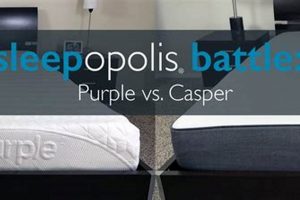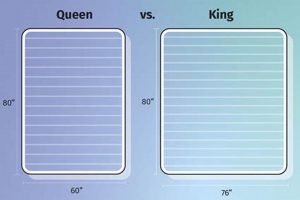The differentiation between a larger and smaller sleeping surface is a common point of consideration when furnishing a bedroom. One option, typically 54 inches wide and 75 inches long, offers a compact solution suitable for individuals or smaller spaces. The other, measuring 60 inches wide and 80 inches long, provides additional width and length, often preferred by couples or individuals desiring more room to stretch out.
Selecting an appropriately sized mattress can significantly impact sleep quality and overall comfort. Factors such as the number of sleepers, the dimensions of the bedroom, and individual preferences for personal space during sleep are critical determinants. Historically, choices were more limited, but current market offerings reflect a diverse range of sizes to accommodate various needs and lifestyles, improving sleep satisfaction for a wider demographic.
Understanding the dimensional differences and their implications is key to making an informed decision. Further considerations include price points, availability of bedding, and suitability for different bedroom layouts. The subsequent sections will explore these factors in greater detail, facilitating a well-informed choice.
Considerations for Selecting Appropriate Mattress Dimensions
Making an informed decision regarding mattress size requires careful evaluation of several pertinent factors. The following points offer guidance on navigating the choice between a larger and smaller sleeping surface.
Tip 1: Assess Room Dimensions. Measure the intended bedroom space to ensure adequate room for the mattress and associated furniture. Smaller rooms often benefit from the space-saving nature of the smaller option, while larger rooms can comfortably accommodate the increased size of the latter.
Tip 2: Evaluate Sleeper Occupancy. Single sleepers generally find the smaller option sufficient, while couples typically require the additional space provided by the larger alternative to minimize sleep disturbance and maximize individual comfort.
Tip 3: Consider Sleep Style. Individuals who tend to move frequently during sleep or prefer ample personal space may benefit from the increased surface area of the larger option. This allows for greater freedom of movement without disrupting a partner or feeling constrained.
Tip 4: Compare Costs. A smaller option generally presents a more economical choice. Evaluate budget constraints and long-term value when weighing the initial purchase price against the potential benefits of the larger alternative.
Tip 5: Examine Bedding Availability. Ensure that bedding options, such as sheets, comforters, and mattress protectors, are readily available in the chosen size. Limited availability or increased prices for specific sizes may influence the final selection.
Tip 6: Account for Future Needs. Anticipate potential changes in sleeping arrangements or living situations. Selecting a larger option may provide greater flexibility in the long term, particularly if co-sleeping or relocation is anticipated.
Tip 7: Review Frame Compatibility. Confirm that existing or planned bed frames are compatible with the dimensions of the chosen mattress. Incompatible frames may compromise support, durability, and overall sleep quality.
Selecting the appropriate mattress dimensions involves a comprehensive evaluation of individual needs, spatial constraints, and budgetary considerations. By carefully assessing these factors, an informed decision can be reached that promotes optimal sleep quality and long-term satisfaction.
With these tips in mind, the subsequent section will explore the lasting impact of choosing between the two options.
1. Room Dimension
Room dimension is a primary determinant in selecting between mattress sizes. A full-size mattress, with its smaller footprint, is often favored in apartments, guest rooms, or smaller bedrooms where spatial efficiency is paramount. Conversely, a queen-size mattress requires a larger room to maintain adequate circulation space and prevent a feeling of overcrowding. Failure to consider room dimensions may result in an impractical arrangement, hindering movement and diminishing the overall comfort of the space. As a real-life example, placing a queen-size mattress in a 10′ x 10′ room could leave minimal space for other essential furniture items like dressers or nightstands, potentially disrupting the room’s functionality. The selection of the mattress directly impacts the room’s usability and aesthetic appeal.
The importance of room dimension extends to the visual perception of the space. A full-size mattress in a larger room might appear disproportionately small, impacting the room’s overall balance. In contrast, a queen-size mattress in a similarly sized room might contribute to a more furnished and complete look. The practical application of this understanding involves carefully measuring the room and considering the placement of other furniture before deciding on a mattress size. This proactive approach avoids potential dissatisfaction and ensures a harmonious integration of the mattress into the existing decor.
In summary, room dimension is intrinsically linked to the selection between mattress sizes, influencing both functionality and aesthetics. Overlooking this critical factor can lead to compromised living spaces and diminished comfort. Careful consideration of room size, furniture placement, and personal preferences are crucial steps in ensuring a successful mattress selection, improving the quality of life within the bedroom.
2. Sleeping Partners
The number of individuals sharing a sleeping surface directly influences the suitability of mattress dimensions. A primary distinction between a full-size and a queen-size mattress lies in their capacity to comfortably accommodate multiple occupants.
- Space per Sleeper
A full-size mattress offers approximately 27 inches of width per sleeper when shared, while a queen-size mattress provides 30 inches. This seemingly small difference can significantly impact comfort levels, particularly for individuals who value personal space during sleep. Insufficient space can lead to disrupted sleep patterns and decreased overall rest quality.
- Movement and Disturbance
The smaller dimensions of a full-size mattress can amplify the impact of movement during sleep. Partners are more likely to experience disturbances caused by tossing, turning, or getting in and out of bed. The greater surface area of a queen-size mattress reduces the transmission of motion, promoting more restful sleep for both individuals.
- Physical Contact Preferences
Partners who prefer to sleep in close proximity may find a full-size mattress adequate, as it encourages closeness. However, individuals who prefer greater separation or who tend to overheat may find the limited space constricting and uncomfortable. A queen-size mattress offers greater flexibility in positioning and reduces the likelihood of unwanted physical contact.
- Individual Size and Build
The physical size of the sleepers is a crucial consideration. Two individuals of smaller stature may find a full-size mattress sufficient, while larger individuals may require the additional space of a queen-size mattress to avoid feeling cramped or restricted. Overlooking this factor can result in discomfort and impaired sleep quality.
In summary, the presence and characteristics of sleeping partners directly inform the selection of mattress size. A queen-size mattress generally offers greater comfort and reduced disturbance for couples, while a full-size option may be suitable for single individuals or smaller couples who prioritize space efficiency. Ultimately, the decision should be based on a careful assessment of individual needs and preferences, considering the potential impact on sleep quality and overall well-being.
3. Individual Space
The availability of personal space during sleep is a critical factor influencing comfort and rest quality. The distinction between a full-size and a queen-size mattress directly impacts the individual space afforded to each sleeper, with downstream effects on sleep patterns, overall well-being, and relationship dynamics. A full-size mattress offers a more constrained sleeping area, which may lead to discomfort and disrupted sleep, especially for individuals accustomed to expansive sleeping surfaces. Conversely, a queen-size mattress provides a larger personal zone, accommodating a wider range of sleeping positions and reducing the likelihood of disturbing a partner. For example, individuals who tend to spread out or move frequently during sleep may find the limitations of a full-size mattress restrictive, resulting in a less restful night. Conversely, the increased surface area of a queen-size mattress allows for greater freedom of movement without impacting a partner, thereby promoting uninterrupted sleep.
The importance of individual space extends beyond mere physical comfort; it also influences psychological well-being. Feeling cramped or confined during sleep can induce feelings of anxiety or restlessness, negatively impacting sleep quality. Conversely, having sufficient personal space promotes a sense of security and relaxation, fostering a more conducive environment for restorative sleep. For example, consider a couple where one partner is a light sleeper. The limited space on a full-size mattress may amplify the impact of the other partner’s movements, leading to frequent awakenings and chronic sleep deprivation. In such cases, upgrading to a queen-size mattress can significantly improve sleep quality by providing each partner with a greater buffer zone, minimizing disturbances and fostering a more peaceful sleep environment.
In summary, the connection between individual space and mattress size is a significant determinant of sleep quality and overall well-being. A full-size mattress may prove inadequate for individuals requiring ample personal space, potentially leading to discomfort and disrupted sleep. Conversely, a queen-size mattress offers a more spacious and accommodating sleeping surface, promoting a more restful and restorative sleep experience. Recognizing the importance of individual space and aligning mattress size accordingly is a crucial step in optimizing sleep quality and fostering a healthier lifestyle. It is also worth noting that preferences vary, and some individuals may find the closeness afforded by a full-size mattress comforting. However, for those prioritizing personal space and undisturbed sleep, a queen-size mattress typically represents a more suitable option.
4. Budget Allocation
Budget allocation is a fundamental consideration when choosing between mattress sizes. A full-size mattress generally represents a lower initial investment compared to a queen-size counterpart. This cost differential stems from the smaller dimensions, requiring fewer materials and less manufacturing effort. Consequently, individuals or households operating within strict budgetary constraints may prioritize the full-size option as a means of minimizing upfront expenses. However, neglecting to consider long-term comfort and potential replacement costs based solely on initial price can lead to an economically unsound decision. For instance, if a full-size mattress proves inadequate, the subsequent need for a queen-size upgrade can negate the initial cost savings.
The importance of budget allocation extends beyond the mattress purchase itself. Bedding, frames, and other accessories also contribute to the overall expenditure. Queen-size bedding and frames typically command higher prices than their full-size equivalents. This discrepancy should be factored into the total budget to avoid unexpected financial burdens. A comprehensive budget should account for all associated costs, including delivery fees, potential warranty expenses, and the anticipated lifespan of the mattress. Furthermore, financing options and promotional discounts should be explored to identify potential cost-saving opportunities. A real-life example would be a student furnishing a first apartment. The lower cost of a full-size mattress and its associated bedding might be the only financially feasible option, allowing resources to be allocated to other essential household items.
In summary, budget allocation is inextricably linked to the choice between mattress sizes. While a full-size mattress offers initial cost advantages, a comprehensive financial assessment should consider long-term comfort, potential replacement costs, and the expense of associated accessories. A well-considered budget, incorporating all relevant factors, enables informed decision-making, ensuring that the selected mattress aligns with both financial capabilities and sleep quality needs. Ignoring budget limitations can lead to financial strain and, ultimately, a less satisfactory sleep experience.
5. Bedding Costs
The expense associated with bedding represents a significant component when deciding between mattress dimensions. A direct correlation exists between mattress size and the cost of corresponding sheets, comforters, duvet covers, and mattress protectors. Generally, bedding designed for a queen-size mattress incurs a higher price point than comparable items intended for a full-size mattress. This differential arises from the increased fabric and manufacturing resources required to accommodate the larger dimensions. Consequently, when evaluating overall expenses, prospective buyers must factor in the ongoing investment in appropriately sized bedding, which can significantly alter the perceived cost advantage of choosing a smaller mattress. For instance, a set of high-quality queen-size sheets may cost substantially more than a similar set for a full-size mattress, potentially influencing the ultimate selection decision.
The importance of considering bedding costs extends beyond the initial purchase. Replacement cycles, material quality, and specialized features further complicate the financial landscape. Bedding materials like Egyptian cotton or silk command premium prices, irrespective of mattress size, but the larger surface area of a queen-size mattress amplifies the overall expenditure. Furthermore, specialized bedding, such as temperature-regulating sheets or hypoallergenic mattress protectors, also contributes to increased costs. In practice, failing to account for these recurring expenses can lead to budgetary strain, particularly for individuals or households operating with limited financial resources. Therefore, a comprehensive assessment of bedding costs should encompass not only the initial investment but also projected replacement frequencies and material preferences.
In conclusion, bedding costs constitute a crucial, yet often overlooked, element in the selection process. The disparity in prices between full-size and queen-size bedding can substantially impact the overall financial burden. A comprehensive analysis, incorporating material preferences, replacement cycles, and specialized features, is essential for making an informed decision. Ignoring these factors can result in inaccurate budgeting and, ultimately, dissatisfaction with the long-term affordability of the chosen mattress size. A thorough understanding of bedding costs ensures that the selection aligns with both budgetary constraints and desired sleep comfort.
6. Longevity Needs
The anticipated lifespan of a mattress is a critical factor influencing the selection between a full-size and queen-size option. Evaluating future requirements and usage patterns contributes significantly to maximizing the value and minimizing the long-term cost of the purchase.
- Anticipated Changes in Occupancy
Potential shifts in sleeping arrangements, such as cohabitation or the growth of children, necessitate consideration of future occupancy needs. A full-size mattress, initially suitable for a single sleeper, may become inadequate if shared. Opting for a queen-size mattress provides greater flexibility to accommodate evolving sleeping arrangements, mitigating the need for premature replacement. A practical example involves a single individual purchasing a mattress for a guest room; while a full-size option might suffice initially, anticipating potential long-term use by a couple warrants consideration of a queen-size selection.
- Wear and Tear Projections
The projected level of wear and tear influences the anticipated lifespan of a mattress. Mattresses subjected to frequent or heavy use tend to degrade more rapidly, potentially requiring earlier replacement. Selecting a higher-quality mattress, regardless of size, can extend its lifespan. However, the larger surface area of a queen-size mattress may distribute wear more evenly, potentially prolonging its usability compared to a full-size mattress subjected to similar stress. As an illustration, a mattress in a frequently used guest room will likely experience more wear than one used only occasionally, thus affecting longevity needs.
- Body Weight and Support Requirements
Body weight and individual support requirements are integral to the longevity of a mattress. Mattresses subjected to excessive weight may experience accelerated compression and degradation, diminishing their support capabilities and lifespan. A queen-size mattress, with its larger surface area and potentially reinforced construction, may provide superior support and durability for heavier individuals or couples compared to a full-size alternative. A real-world scenario involves a heavier individual consistently sleeping on a full-size mattress; the concentrated pressure may lead to premature sagging and reduced comfort, highlighting the need for a more robust queen-size option.
- Technological Advancements and Future Preferences
Anticipating technological advancements in mattress design and evolving personal preferences can impact longevity needs. Choosing a mattress with features designed to enhance durability or accommodate changing comfort preferences may extend its usable lifespan. A queen-size mattress may offer a wider range of features or construction options that cater to evolving needs. For example, selecting a mattress with adjustable firmness or advanced cooling technology may prolong its relevance and minimize the likelihood of needing an early replacement due to changing preferences.
Evaluating longevity needs in the context of mattress size involves assessing future occupancy, wear and tear projections, support requirements, and anticipating technological advancements. Considering these factors facilitates a well-informed decision, ensuring that the selected mattress size aligns with long-term requirements and maximizes the value of the investment. By proactively addressing longevity concerns, individuals can minimize the likelihood of premature replacement and optimize sleep quality over an extended period.
Frequently Asked Questions
This section addresses common inquiries regarding the selection between different mattress dimensions, providing concise answers to facilitate informed decision-making.
Question 1: What are the exact dimensions of each mattress type?
A full-size mattress typically measures 54 inches in width and 75 inches in length. A queen-size mattress measures 60 inches in width and 80 inches in length.
Question 2: Is a larger mattress always preferable for couples?
While a larger mattress generally provides more space, room size and individual preferences play a significant role. Couples should assess their comfort needs and spatial constraints before selecting a mattress.
Question 3: How does the cost of bedding differ between sizes?
Bedding for queen-size mattresses typically costs more than bedding for full-size mattresses due to the increased fabric and manufacturing resources required.
Question 4: What room size is best suited for each mattress dimension?
A full-size mattress is often suitable for smaller rooms, such as guest rooms or apartments. A queen-size mattress requires a larger room to maintain adequate circulation space.
Question 5: Can frame compatibility influence mattress selection?
Existing or planned bed frames must be compatible with the dimensions of the chosen mattress. Incompatible frames may compromise support and durability.
Question 6: How do future needs impact the decision?
Anticipating changes in sleeping arrangements or living situations is crucial. Selecting a larger option may provide greater flexibility in the long term.
Key takeaways involve careful assessment of room size, personal preferences, and budget considerations when choosing between mattress dimensions.
The subsequent section will offer a concise summary encapsulating the key aspects of this analysis.
Conclusion
The preceding analysis has explored the critical factors influencing the selection between a full size mattress vs queen size mattress. Room dimensions, sleeper occupancy, individual space preferences, budget allocations, bedding costs, and longevity needs all serve as significant determinants in this decision-making process. The analysis highlights that no single mattress size is universally optimal; instead, the ideal choice depends on a comprehensive evaluation of individual circumstances and priorities.
The differential between a full size mattress vs queen size mattress directly impacts sleep quality, spatial efficiency, and long-term financial commitments. Informed consideration of these elements enables a selection that aligns with both practical constraints and desired comfort levels, ultimately contributing to enhanced sleep and overall well-being. Further independent research and in-person evaluation are encouraged to solidify an appropriate choice.







